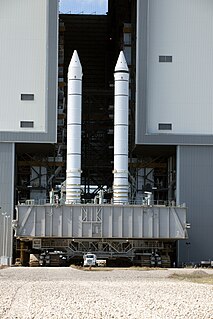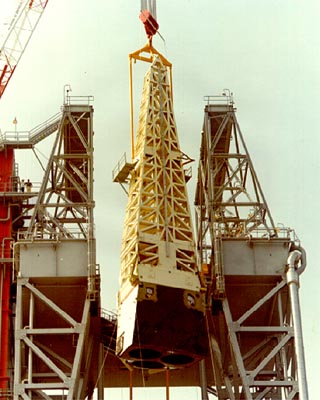
The Space Shuttle was a partially reusable low Earth orbital spacecraft system operated from 1981 to 2011 by the National Aeronautics and Space Administration (NASA) as part of the Space Shuttle program. Its official program name was Space Transportation System (STS), taken from a 1969 plan for a system of reusable spacecraft where it was the only item funded for development. The first of four orbital test flights occurred in 1981, leading to operational flights beginning in 1982. Five complete Space Shuttle orbiter vehicles were built and flown on a total of 135 missions from 1981 to 2011, launched from the Kennedy Space Center (KSC) in Florida. Operational missions launched numerous satellites, interplanetary probes, and the Hubble Space Telescope (HST). The orbiter vehicles also conducted science experiments in orbit, participated in the Shuttle-Mir program with Russia, and participated in construction and servicing of the International Space Station (ISS). The Space Shuttle fleet's total mission time was 1,322 days, 19 hours, 21 minutes and 23 seconds.

Space Shuttle Challenger was the second orbiter of NASA's Space Shuttle program to be put into service, after Columbia. Challenger was built by Rockwell International's Space Transportation Systems Division, in Downey, California. Its maiden flight, STS-6, began on April 4, 1983. The orbiter was launched and landed nine times before disintegrating 73 seconds into its tenth mission, STS-51-L, on January 28, 1986, resulting in the deaths of all seven crew members including a civilian school teacher.
98 (ninety-eight) is the natural number following 97 and preceding 99.

STS-93 in 1999 marked the 95th launch of the Space Shuttle, the 26th launch of Columbia, and the 21st night launch of a Space Shuttle. Eileen Collins became the first female shuttle Commander on this flight. Its primary payload was the Chandra X-ray Observatory. It would also be the last mission of Columbia until March 2002. During the interim, Columbia would be out of service for upgrading, and would not fly again until STS-109. The launch was originally scheduled for 20 July but the launch was aborted at T−7 seconds. The successful launch of the flight occurred 3 days later. The payload was also the heaviest payload ever carried by the Space Shuttle system, at over 22.7 tonnes.

The Apollo spacecraft was composed of three parts designed to accomplish the American Apollo program's goal of landing astronauts on the Moon by the end of the 1960s and returning them safely to Earth. The expendable (single-use) spacecraft consisted of a combined command and service module (CSM) and an Apollo Lunar Module (LM). Two additional components complemented the spacecraft stack for space vehicle assembly: a spacecraft–LM adapter (SLA) designed to shield the LM from the aerodynamic stress of launch and to connect the CSM to the Saturn launch vehicle and a launch escape system (LES) to carry the crew in the command module safely away from the launch vehicle in the event of a launch emergency.

The Space Shuttle Solid Rocket Booster was the first solid-propellant rocket to be used for primary propulsion on a vehicle used for human spaceflight and provided the majority of the Space Shuttle's thrust during the first two minutes of flight. After burnout, they were jettisoned and parachuted into the Atlantic Ocean where they were recovered, examined, refurbished, and reused.

The Lockheed Martin X-33 was an uncrewed, sub-scale technology demonstrator suborbital spaceplane developed in the 1990s under the U.S. government–funded Space Launch Initiative program. The X-33 was a technology demonstrator for the VentureStar orbital spaceplane, which was planned to be a next-generation, commercially operated reusable launch vehicle. The X-33 would flight-test a range of technologies that NASA believed it needed for single-stage-to-orbit reusable launch vehicles, such as metallic thermal protection systems, composite cryogenic fuel tanks for liquid hydrogen, the aerospike engine, autonomous (uncrewed) flight control, rapid flight turn-around times through streamlined operations, and its lifting body aerodynamics.

The Space Shuttle Pathfinder is a Space Shuttle test simulator made of steel and wood. Constructed by NASA in 1977 as an unnamed facilities test article, it was purchased in the early 1980s by the America-Japan Society, Inc. which had it refurbished, named it, and placed it on display in the Great Space Shuttle Exhibition in Tokyo. The mockup was later returned to the United States and placed on permanent display at the U.S. Space & Rocket Center in Huntsville, Alabama, in May 1988.

The Aerojet Rocketdyne RS-25, also known as the Space Shuttle main engine (SSME), is a liquid-fuel cryogenic rocket engine that was used on NASA's Space Shuttle. NASA is planning to continue using the RS-25 on the Space Shuttle's successor, the Space Launch System (SLS).

The John C. Stennis Space Center (SSC) is a NASA rocket testing facility in Hancock County, Mississippi, on the banks of the Pearl River at the Mississippi–Louisiana border. As of 2012, it is NASA's largest rocket engine test facility. There are over 30 local, state, national, international, private, and public companies and agencies using SSC for their rocket testing facilities.

The F-1 is a gas generator-cycle rocket engine developed in the United States by Rocketdyne in the late 1950s and used in the Saturn V rocket in the 1960s and early 1970s. Five F-1 engines were used in the S-IC first stage of each Saturn V, which served as the main launch vehicle of the Apollo program. The F-1 remains the most powerful single combustion chamber liquid-propellant rocket engine ever developed.

The J-2 was a liquid-fuel cryogenic rocket engine used on NASA's Saturn IB and Saturn V launch vehicles. Built in the U.S. by Rocketdyne, the J-2 burned cryogenic liquid hydrogen (LH2) and liquid oxygen (LOX) propellants, with each engine producing 1,033.1 kN (232,250 lbf) of thrust in vacuum. The engine's preliminary design dates back to recommendations of the 1959 Silverstein Committee. Rocketdyne won approval to develop the J-2 in June 1960 and the first flight, AS-201, occurred on 26 February 1966. The J-2 underwent several minor upgrades over its operational history to improve the engine's performance, with two major upgrade programs, the de Laval nozzle-type J-2S and aerospike-type J-2T, which were cancelled after the conclusion of the Apollo program.

The Aerojet Rocketdyne RS-68 is a liquid-fuel rocket engine that uses liquid hydrogen (LH2) and liquid oxygen (LOX) as propellants in a gas-generator power cycle. It is the largest hydrogen-fueled rocket engine ever flown.
Each NASA Space Shuttle designation was composed of a prefix and suffix separated by a dash. The prefix for operational shuttles is OV, for Orbiter Vehicle.

Buran was the first spaceplane to be produced as part of the Soviet/Russian Buran programme. Besides describing the first operational Soviet/Russian shuttle orbiter, "Buran" was also the designation for the entire Soviet/Russian spaceplane project and its orbiters, which were known as "Buran-class orbiters".

The Space Shuttle orbiter is the spaceplane component of the Space Shuttle, a partially reusable orbital spacecraft system that was part of the discontinued Space Shuttle program. Operated from 1977 to 2011 by NASA, the U.S. space agency, this vehicle could carry astronauts and payloads into low Earth orbit, perform in-space operations, then re-enter the atmosphere and land as a glider, returning its crew and any on-board payload to the Earth.

Vulcain is a family of European first stage rocket engines for Ariane 5 and the future Ariane 6. Its development began in 1988 and the first flight was completed in 1996. The updated version of the engine, Vulcain 2, was first successfully flown in 2005. Both members of the family use liquid oxygen/liquid hydrogen cryogenic fuel. The new version under development for Ariane 6 will be called Vulcain 2.1.

The Soviet RD-0120 was the Energia core rocket engine, fueled by LH2/LOX, roughly equivalent to the Space Shuttle Main Engine (SSME). These were attached to the Energia core rather than the orbiter, so were not recoverable after a flight, but created a more modular design. The RD-0120 and the SSME have both similarities and differences. The RD-0120 achieved a slightly higher specific impulse and combustion chamber pressure with reduced complexity and cost, as compared to the SSME. It uses a fuel-rich staged combustion cycle and a single shaft to drive both the fuel and oxidizer turbopumps. Some of the Russian design features, such as the simpler and cheaper channel wall nozzles, were evaluated by Rocketdyne for possible upgrades to the SSME. It achieved combustion stability without the acoustic resonance chambers that the SSME required.

The Shuttle-Derived Heavy Lift Launch Vehicle ("HLV") was an alternate super heavy-lift launch vehicle proposal for the NASA Constellation program. It was first presented to the Augustine Commission on 17 June 2009.

United States Air Force Plant 42 is a classified aircraft manufacturing plant owned by the United States Air Force in the Antelope Valley, about 60 miles (97 km) from downtown Los Angeles. It is also used by the National Aeronautics and Space Administration (NASA).























